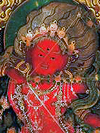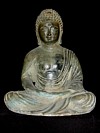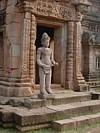|
dakini (डाकिनी)
Sanskrit. A yogini or female divinity of low rank
in Vajrayana Buddhism. There are two forms, malevolent and benevolent.
There is a group of five dakinis associated with the five jinas, each
holding a jewel, a lotus, or a double thunderbolt. A dakini may be
distinguished from an apsarsa by the presence of a 'third eye' or urna
in the middle of the forehead. In Hinduism dakinis are female imps who
wait upon Kali and feed on human flesh. Her name is related to the Hindi
word dakin, meaning 'witch' and is sometimes translated as 'sky dancer',
as she 'carries the souls of the dead to the sky'.


Daksha (दक्ष)
Sanskrit. 'Able', 'competent' and
'intelligent'. Son of Brahma and usually associated with the idea of
creative power. Through his mother's side he is a one of the Adityas.
His consort is Prasuti, with whom he has thirteen daughters. After some
sinful acts in which Daksha mocked and dishonored a statue of his
son-in-law Shiva, Sati, his daughter and Shiva's first consort,
committed suicide. This enraged Shiva, who created the ferocious Virabhadra and Rudrakali from the locks of his matted hair, called jata.
Together with Bhadrakali, who arose from the wrath of Devi, they set out
to wreak mayhem in which Daksha was killed. Shiva, however, later
restored Daksha's life, with the head of a goat.

Dakshayani
(दाक्षायनि)
Sanskrit. Another designation for Sati, as the
daughter of Daksha.

Dalai Lama
Tibetan. 'Ocean of Wisdom'. High priest of the
Tibetan Buddhists, and from the 17th century AD until 1959 also worldly
ruler of Tibet. In Tibetan Buddhism he is considered an incarnation of
the bodhisatva Avalokitesvara.

Dandadhara
Sanskrit. 'The rod-bearer'. A name given to Yama, the god of death.

darbas
Sanskrit. General name for destructive demons,
such as the Rakshasas.

Daruka (दरुक)
Sanskrit. The charioteer and companion of
Krishna, who attended him in his final days.

Dasharatha
(दशरथ)
Sanskrit. Father of Rama, king of Kosala in the
Ramayana, the Indian and original version of the epic. In the Thai
version, the Ramakien, the father is called Totsarot but he is also
known as Suddhodana. Also transcribed Dasaratha.

deer
In Buddhism deer often refer to Mrigadava, the
deer park where the Buddha delivered his first sermon. In Thai
mythology, where it is called kwahng or mareuk for a male and mareuki
for a female, it is the mount of Phra Phareuhadsabodih, the god of
Thursday.


deva (देव)
Sanskrit. A god of undetermined rank. They are
believed to be thirty three in number, eleven for each of the three
worlds of Buddhist cosmology.

Devadatta
(देवदत्त)
Sanskrit. Name of a son of King Suppabuddha and
his wife Pamita, who was an aunt of Siddhartha. Since he was also
the brother of Yashodhara, he was both a cousin and brother-in-law
of the Buddha. He was an evil monk who, unable to attain any stage
of sainthood, became jealous and plotted to harm the Buddha. He
first attempted to kill the Buddha by hiring a man to kill him. The
murderer would than be killed by two other men, who in turn would be
killed by four other men, who finally would be killed by eight other
men. But the cunning plan failed as all the murderers, upon coming
close to the Blessed One, scared out and took refuge in him.
Devadatta then tried to kill the Buddha himself by hurling a huge
stone at him, during a climb on Vulture's Rock, but the Buddha got
only hurt on his foot. In his third attempt, Devadatta made a fierce
man-killer elephant, known as Nalagiri, drunk with toddy and set it
loose to charge the Buddha, who though calmed the elephant by
radiating his loving kindness. Devadatta eventually died failing in
his wicked plan and sincerely regretting his wrongful actions.

devaputra
(देवपुत्र)
Sanskrit. Devas, male flying, heavenly
creatures. In Pali called devaputta.

devaraja (देवराज)
Sanskrit. 'King of the gods'. A title often
applied to both Indra and the Buddha. In Java and Cambodia, a cult
of devaraja developed that claimed the king was an emanation of a
god and would be reunited with that god after death.

devata (देवता)
Sanskrit. A female deity in Cambodian art.

Devi (देवी)
Sanskrit. Title given to Parvati, the shakti or
consort of Shiva, and a goddess with many forms, both good and bad.
Her good forms are Uma 'light', Sati 'the virtuous one', Annapurna
'the one who bestows good deeds', Haimavati 'born of the Himalayas',
Jagamata 'mother of the world', and Bhavani 'the female creator'.
Her terrible forms are Durga 'inaccessible', Kali, Mahakali or
Shyama 'black', Chandi 'fierce', and Bhairavi 'terrible'. Her mount
is the lion.

_small.jpg)
dhammapala
Pali. 'Defender of the Buddhist law'. In
Vajrayana Buddhism they wage war against the demons and enemies of
the faith, and have terrifying appearances. In Sanskrit dharmapala.

Dhanapala (धनपाल)
Sanskrit-Pali. 'Wealth Protector', but in
Sanskrit also 'Begging Bowl Receptacle'. Another name for the
elephant Nalagiri, that attacked the Buddha when he was on alms
round and hence carried an alms bowl.

Dhanus (धनुस्)
Sanskrit. 'Bow'. The mighty bow that surfaced
during the churning of the Ocean of Milk and was given to Vishnu's
avatar, Rama. The Thai word for bow, thanu (ธนู), derives from it.
Sometimes transcribed Dhanush.

dhyani (ध्यानि)
Sanskrit. 'Concentration'. According to Mahayana Buddhism there are five
transcendental buddha's, four for the main directions and one for
the zenith. They are usually portrayed seated in meditation, the
most popular being Amitabha, the buddha of the western paradise.


dikpala
Sanskrit. One of the eight listed guardians of
the main and intermediate directions of the sky, who protect the
world from demons. They are often depicted on Hindu temples facing
different directions. Four dikpalas are guarding the cardinal points
and another four the intermediate directions.

Dipankara
Sanskrit. 'Lamp bearer'. The first of 24 buddha
predecessors, who pledges to the ascetic Brahman Sumedha that he
will one day become a buddha. Sumedha was an former incarnation of
Siddhartha Gautama, who later became the historical Buddha.

Dona
Sanskrit. A brahmin sage who after the Buddha's
cremation divided the relics of the Buddha among eight warring
kings.

dragon
A mythical, usually winged, monster like a
reptile, able to breathe fire. In ancient Chinese mythology the
earth's natural process of procreation takes the form of a dragon,
animating all things in the unending cycle of life, death and
rebirth. It embodies the process of change itself, appearing only to
disappear again, thus being in constant transformation. It therefore
appears frequently in Chinese festivals, especially during Trut Jihn,
the Chinese lunar new year. It has since long been the national
symbol of the Chinese and is frequently seen in iconography as well
as in architecture. The dragon is also the fifth animal of the
Chinese zodiac as the fifth year of the animal cycle.


dragon tortoise
Name of an auspicious animal from Chinese
mythology. It has the characteristics of two kinds of favourable
animals, i.e. the tortoise and the dragon. It is depicted with the
head of a dragon and the body of a tortoise. It is the symbol of
longevity and power, because the tortoise is an animal with a long
life, whereas the dragon is animal with an enormous strength.
It is thus a combination of the great virtues of both the dragon and
the tortoise, two out of the four animals from Chinese paradise.
Those four animals are the tortoise, the dragon, the hongse and the
tiger. The tortoise with dragonhead embodies the intelligence and
ability, that comes with courage, and the prestigious and
influential power of the dragon, as well as the steadfast power,
endurance, happiness and lasting physical force of the tortoise. A
statue of the dragon tortoise is believed to have the power to bring
about or enhance progress, strength, fortune, influence, etc.,
depending on how the statues is placed with regard to the points of
the compass. It is sometimes depicted with the characteristics of
all four animals from Chinese paradise, i.e. the tortoise, the
dragon, the hongse and the tiger. A female dragon turtle is, like
the Rui Shi lion, usually depicted with a young.


Durga (दुर्गा)
Sanskrit. 'Inaccessible'. A form of Devi,
Shiva's consort, usually portrayed riding a tiger or lion. In
Javanese and Indian art she is frequently depicted as slaying the
buffalo demon Mahishasura with divine weapons.

Dusit (ดุสิต)
Sanskrit-Thai. 'Satisfied' of 'fulfilled'. The
term refers to the heaven above Mt. Meru where the bodhisattvas
await their last existence on earth. It is one of the highest
heavens in Buddhist cosmology, and the heaven in which the
bodhisattva who would later become the Buddha was reborn, after
gaining sufficient merit in previous lives. It is the last place
where he stayed before being born as prince Siddhartha, as well as
the heaven where the future Maitreya buddha dwells. In Hinduism it
is the fourth heaven. Also Tusita and Tushita.

dvarapala
(द्वारपाल)
Sanskrit. 'Janitor'. A guardian of a temple
entrance often holding a club or mace (gada).

 |